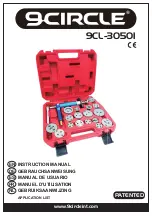
4
• Wear a dust respirator mask or a dual filter (dust and fume) respirator mask
which has been approved by the Occupational Safety and Health Administration
(OSHA), the National Institute of Safety and Health (NIOSH), or the United States
Bureau of Mines. These masks and replaceable filters are readily available at
major hardware stores. Be sure the mask fits. Beards and facial hair may keep
masks from sealing properly. Change filters often.
DISPOSABLE PAPER MASKS
ARE NOT ADEQUATE.
• Use caution when operating the heat gun. Keep the heat gun moving as excessive
heat will generate fumes which can be inhaled by the operator.
• Keep food and drink out of the work area. Wash hands, arms and face and rinse
mouth before eating or drinking. Do not smoke or chew gum or tobacco in the
work area.
• Clean up all removed paint and dust by wet mopping the floors. Use a wet cloth
to clean all walls, sills and any other surface where paint or dust is clinging.
DO NOT SWEEP, DRY DUST OR VACUUM.
Use a high phosphate detergent or
trisodium phosphate (TSP) to wash and mop areas.
• At the end of each work session put the paint chips and debris in a double plastic
bag, close it with tape or twist ties, and dispose of properly.
• Remove protective clothing and work shoes in the work area to avoid carrying
dust into the rest of the dwelling. Wash work clothes separately. Wipe shoes off
with a wet rag that is then washed with the work clothes. Wash hair and body
thoroughly with soap and water.
WARNING: ALWAYS
use safety glasses. Everyday eyeglasses are NOT safety
glasses. Also use face or dust mask if cutting operation is dusty. ALWAYS WEAR
CERTIFIED SAFETY EQUIPMENT:
• ANSI Z87.1 eye protection (CAN/CSA Z94.3),
• ANSI S12.6 (S3.19) hearing protection,
• NIOSH/OSHA/MSHA respiratory protection.
WARNING:
Some dust created by power sanding, sawing, grinding, drilling, and
other construction activities contains chemicals known to cause cancer, birth defects
or other reproductive harm. Some examples of these chemicals are:
• lead from lead-based paints,
• crystalline silica from bricks and cement and other masonry products, and
As you become more familiar with the tool and develop the proper technique, the danger
of accidental ignition will be greatly reduced. In establishing the proper technique, the
best thing to do is PRACTICE! Work on simple stripping projects, preferably outdoors,
until you get a “feel” for how to use your stripper safely and effectively.
AS YOU PRACTICE, OBSERVE THE FOLLOWING PROCEDURES FOR SAFETY:
• Always be sure the tool is turned off and disconnected from power supply when
unattended.
• Clean the scraper blade often during use. Built up residue on the blade is highly
flammable.
• Experiment to find the optimum distance from the tool’s nozzle to the surface
being stripped. This distance (usually 25.4 mm– 50.8 mm) will vary depending
on the material being removed.
• Keep the heat gun moving ahead of the scraper blade at all times.
• As you work, clean up loose pieces of paint as they accumulate around the work
area.
• When working indoors, keep away from curtains, papers, upholstery and similar
flammable materials.
• Above all, remember that this is a serious tool that is capable of producing
excellent results when used properly. Practice on simple projects until you feel
comfortable with your stripper. Only then will you have mastered the proper
technique.
PERSONS REMOVING PAINT SHOULD ALWAYS FOLLOW THESE GUIDELINES:
• Move the work piece outdoors. If this is not possible, keep the work area well
ventilated. Open the windows and put an exhaust fan in one of them. Be sure the
fan is moving the air from inside to outside.
• Remove or cover any carpets, rugs, furniture, cooking utensils, and air ducts.
• Place drop cloths in the work area to catch any paint chips or peelings. Wear
protective clothing such as extra work shirts, overalls and hats.
• Work in one room at a time. Furnishings should be removed or placed in the
center of the room and covered. Work areas should be sealed off from the rest of
the dwelling by sealing doorways with drop cloths.
• Children, pregnant women or potentially pregnant women and nursing mothers
should not be present in the work area until the work is done and all clean up is
complete.
Содержание D26411-XE
Страница 1: ...D26411 XE D26414 XE HEAT GUN INSTRUCTION MANUAL ...
Страница 2: ......






























